Millions of Americans may see reduced Social Security payments and smaller tax refunds starting in May 2025 due to the reinstatement of federal student loan collections.
The Department of Education (DOE) has announced that the Treasury Offset Program (TOP) will resume, targeting borrowers in default by withholding government benefits to recover unpaid debts.
This marks the end of a pandemic-related pause and is expected to financially impact over 5 million borrowers who are either in default or late-stage delinquency on their federal student loans.
Why Are Social Security and Tax Refunds Being Reduced?
The Treasury Offset Program is a government mechanism that allows the Treasury to withhold federal payments like tax refunds, Social Security benefits, and other forms of federal assistance from those who owe money to the government.
Beginning May 5, 2025, student loan debts in default will be subject to this recovery method.
The Department of Education clarified that there will be no mass loan forgiveness, signaling a stricter approach toward debt collection.
Breakdown of the Collection Process
The government has laid out a phased approach to resume debt collection. Here’s how it will unfold:
Step-by-Step Timeline:
| Stage | Details |
|---|---|
| Notifications Sent | Borrowers in default will receive emails with guidance to repay or enter a plan. |
| Deadline to Act | May 5, 2025 – Failing to act will result in referral to the Treasury Offset Program. |
| Offset Commences | Tax refunds, Social Security benefits, and other payments may be withheld to recover debt. |
| Social Security Cap | Up to 15% of benefits can be withheld, but monthly checks must not fall below $750 to protect a basic income level. |
| Wage Garnishment | Up to 15% of disposable income can be garnished for working individuals in default, further adding to financial pressure. |
Who Will Be Affected?
According to the DOE, this initiative will target:
- Over 5.3 million borrowers in default (no payment for over 9 months)
- Roughly 4 million borrowers in late-stage delinquency
- Borrowers not enrolled in any repayment or income-driven repayment (IDR) plan
Those receiving Social Security retirement, disability, or survivor benefits and expecting a tax refund could be among the most impacted if they have unresolved loan defaults.
Options to Avoid Garnishment or Offsets
Borrowers still have time to avoid these penalties. The Default Resolution Group offers assistance for enrolling in repayment plans or resolving default status.
Specifically, income-driven repayment (IDR) plans are available, which calculate payments based on income and family size, offering a path to long-term relief.
Financial Implications for Americans
This policy shift could have significant consequences for financially vulnerable groups:
- Seniors relying solely on Social Security
- Low-income workers expecting tax refunds to cover bills or emergencies
- Families already managing tight budgets
With wage garnishment and federal benefit offsets both coming into effect, it’s critical that affected individuals take action before the May 5 deadline.
The resumption of the Treasury Offset Program marks a significant shift in the federal government’s handling of student loan defaults.
With millions of Americans at risk of losing part of their Social Security payments and tax refunds, the impact will be widespread—especially among seniors and low-income families.
Acting now by enrolling in a repayment plan or resolving default status is the best way to avoid financial setbacks starting May 2025.
FAQs
How much of my Social Security payment can be withheld?
The Treasury can withhold up to 15%, but your monthly benefit cannot drop below $750.
Can the government take my entire tax refund?
Yes, the government can withhold your entire tax refund if you are in default on your student loan.
What should I do if I’m in default?
Contact the Default Resolution Group or visit the federal loan website to enroll in a repayment plan or settle the debt before May 5.

